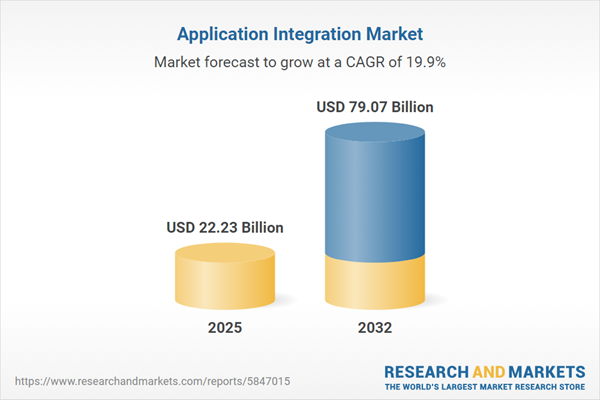Speak directly to the analyst to clarify any post sales queries you may have.
Application integration is essential for modern enterprises seeking to unify technology systems, enhance workflow automation, and maintain agility in the face of evolving market demands. Senior decision-makers increasingly recognize the role of effective integration in sustaining digital initiatives and enabling future-ready business models.
Market Snapshot: Application Integration Market Size & Growth
The global application integration market reached USD 18.50 billion in 2024 and is projected to grow to USD 22.23 billion by 2025. Long-term forecasts indicate further expansion to USD 79.07 billion by 2032, representing a compound annual growth rate (CAGR) of 19.90%. This steady trajectory signals robust global adoption as businesses pursue digital transformation, process optimization, and stronger response capabilities to shifting regulatory requirements. Integrated systems now underpin competitive advantage across organizations at all maturity stages, positioning application integration at the core of enterprise technology strategies.
Scope & Segmentation of the Application Integration Market
This report delivers a detailed exploration of the application integration market, equipping decision-makers with actionable insights on critical segments, regional trends, and technology drivers. Coverage of the full ecosystem enables enterprise leaders to benchmark integration strategies, identify innovation opportunities, and ensure alignment with operational goals and compliance frameworks.
- Integration Platform Types: Application integration, B2B integration, data integration, IoT integration, and platform as a service give organizations a path to scalable infrastructure and digital acceleration.
- Middleware Solutions: API management, enterprise service bus, message-oriented middleware, and data integration middleware support secure, reliable connectivity between cloud and on-premises environments.
- Professional Services: Consulting, implementation, support, and maintenance ensure effective integration planning, project execution, and ongoing system optimization.
- Deployment Modes: Private cloud, public cloud, hybrid, and on-premises options empower enterprises to balance control, scalability, and compliance needs.
- Organization Sizes: Large enterprises and small to medium-sized organizations benefit from integration tailored to their resource requirements and investment priorities.
- End User Industries: Banking, financial services, insurance, government, healthcare, life sciences, energy, oil & gas, utilities, manufacturing, retail, IT services, telecommunications, logistics, transportation, and consumer goods represent sectors driving demand for agile integration.
- Regional Coverage: North America, Latin America, Europe, the Middle East, Africa, and Asia-Pacific are analyzed for regulatory trends and unique adoption drivers, supporting region-specific planning.
- Key Vendors Covered: IBM, Microsoft, Oracle, SAP, Software AG, TIBCO Software, Dell Boomi, Informatica, MuleSoft, and SnapLogic are profiled to help organizations evaluate vendor capabilities and partnership opportunities.
Application Integration: Key Takeaways for Senior Decision-Makers
- Effective application integration streamlines workflows and bridges data silos, enabling faster response to operational and strategy changes in hybrid IT landscapes.
- Cloud-native approaches, including microservices and containerization, foster agility, support quick adaptation, and reduce project timelines for digital initiatives.
- Modern integration platforms incorporate AI and machine learning, offering adaptive process automation and reliable data flows across increasingly complex architectures.
- Adoption of resilient integration is crucial for distributed enterprises, especially as the demand for edge computing and IoT grows in geographically diverse operations.
- API-focused frameworks support incremental integration and modular system updates, making it easier to onboard partners and extend digital capabilities as needs evolve.
- Industry-specific strategies enhance compliance and secure data exchange, particularly in highly regulated environments such as financial services, healthcare, and energy.
Tariff Impact on Application Integration Strategies
With new United States tariffs on software and hardware planned for 2025, enterprises must reassess platform sourcing and deployment. Strategic actions include evaluating nearshoring for supply chain stability, transitioning to flexible subscription-based models for improved cost management, and pursuing localized data hosting to meet compliance obligations. Service providers are evolving their approaches to help organizations achieve operational continuity and mitigate emerging risks within the new trade landscape.
Methodology & Data Sources
The findings in this report draw from a blend of industry publications, regulatory documents, and real-world case studies. Primary insights were gathered through interviews with IT leaders and integration specialists. Collaborative surveys and peer validation contribute to the credibility of analysis, supporting confident strategic planning for enterprises.
Why This Report Matters to Enterprise Leaders
- Empowers leadership to design agile, scalable integration strategies that align with shifting priorities and business objectives.
- Supports early identification and management of regulatory, compliance, and tariff-related risks, safeguarding continuity and resilience.
- Equips decision-makers with current intelligence on technology trends, vendor capabilities, and evolving market direction for informed investments.
Conclusion: Navigating Application Integration for Sustainable Growth
This report provides enterprise leaders with strategic insights to drive digital transformation, enhance integration effectiveness, and uphold long-term competitiveness as technology and market conditions rapidly evolve.
Additional Product Information:
- Purchase of this report includes 1 year online access with quarterly updates.
- This report can be updated on request. Please contact our Customer Experience team using the Ask a Question widget on our website.
Table of Contents
3. Executive Summary
4. Market Overview
7. Cumulative Impact of Artificial Intelligence 2025
List of Figures
Samples

LOADING...
Companies Mentioned
The key companies profiled in this Application Integration market report include:- International Business Machines Corporation
- Microsoft Corporation
- Oracle Corporation
- SAP SE
- Software AG
- TIBCO Software Inc.
- Dell Boomi, Inc.
- Informatica LLC
- MuleSoft LLC
- SnapLogic, Inc.
Table Information
| Report Attribute | Details |
|---|---|
| No. of Pages | 196 |
| Published | October 2025 |
| Forecast Period | 2025 - 2032 |
| Estimated Market Value ( USD | $ 22.23 Billion |
| Forecasted Market Value ( USD | $ 79.07 Billion |
| Compound Annual Growth Rate | 19.9% |
| Regions Covered | Global |
| No. of Companies Mentioned | 11 |









